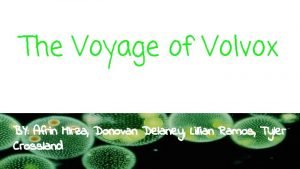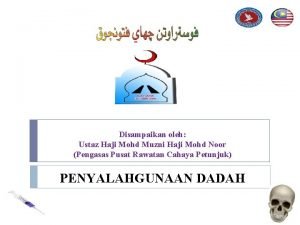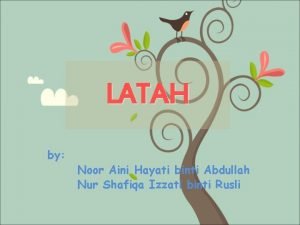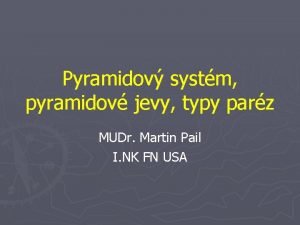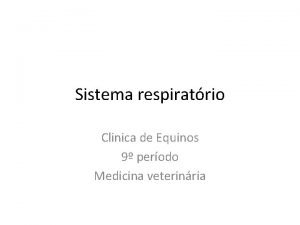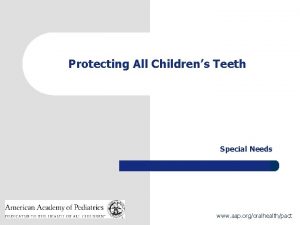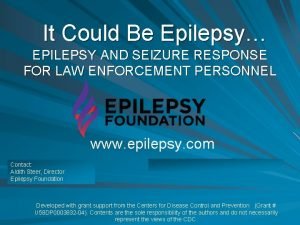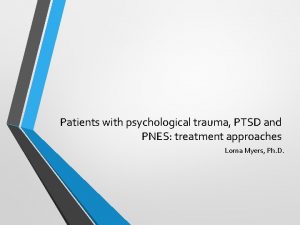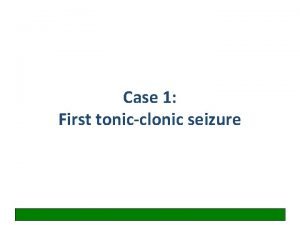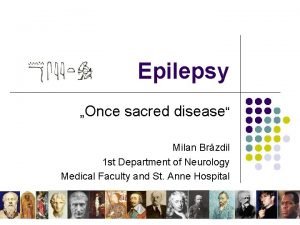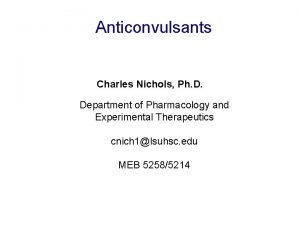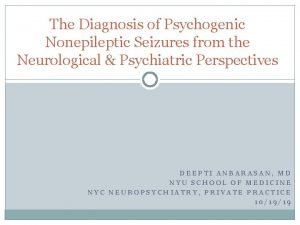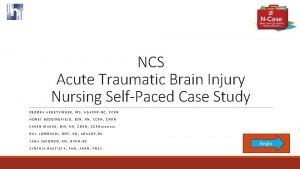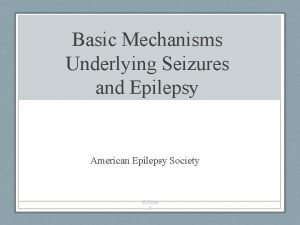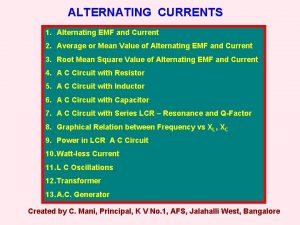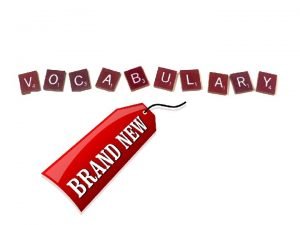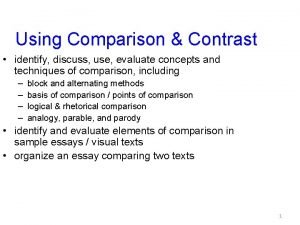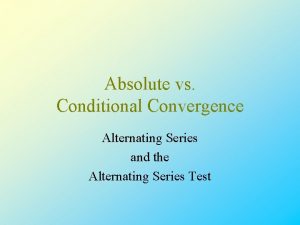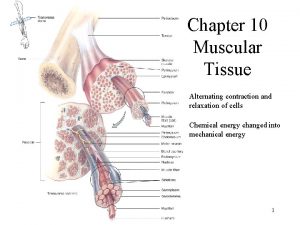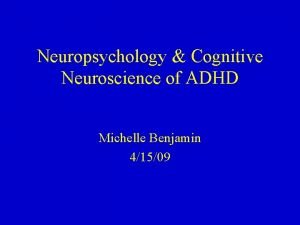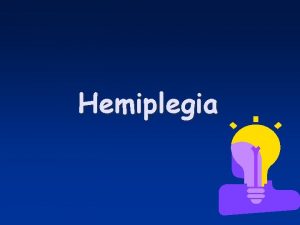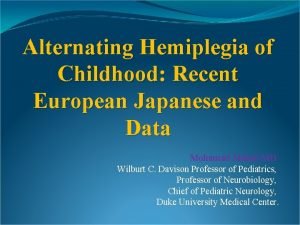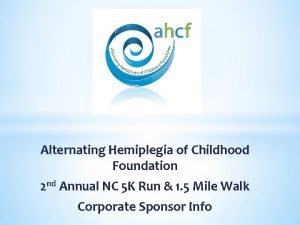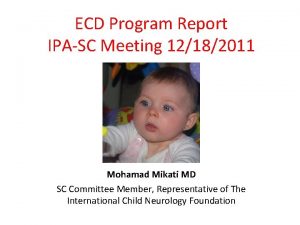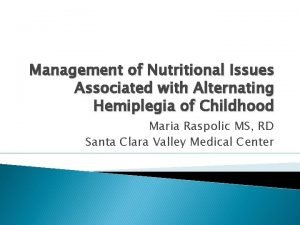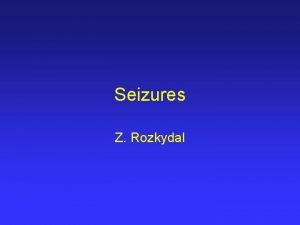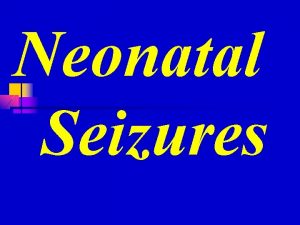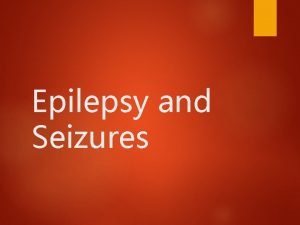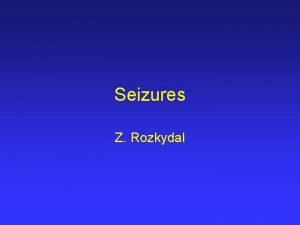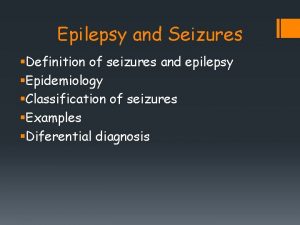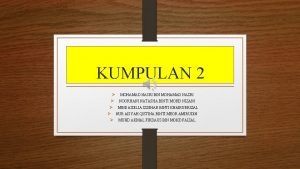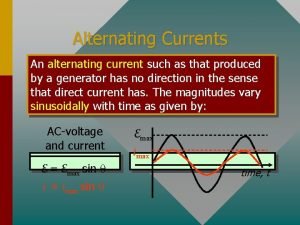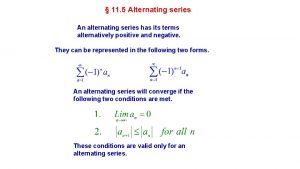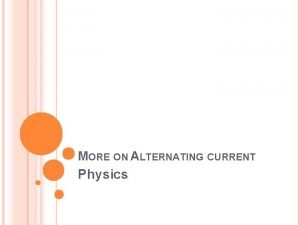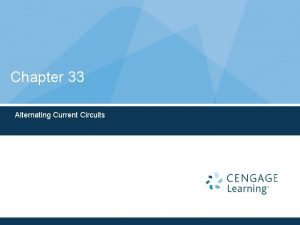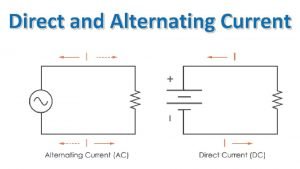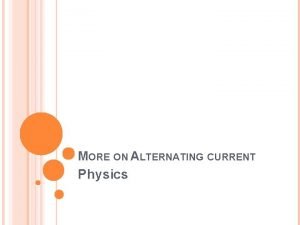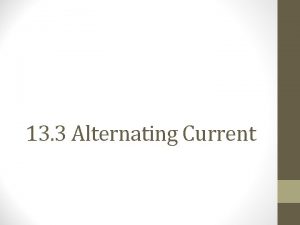Seizures in Alternating Hemiplegia of Childhood Mohamad Mikati

































- Slides: 33

Seizures in Alternating Hemiplegia of Childhood Mohamad Mikati MD Wilburt C. Davison Professor of Pediatrics, Professor of Neurobiology, Chief of Pediatric Neurology, Duke University Medical Center

Milestones in AHC and Parallels with Epilepsy Defining the Syndrome: Verret and Steele, 1971 Casaer and Azou, 1984 Aicardi, 1987 Silver&Andermann, 1993 Bourgeois et al, 1993 Genetics: Mikati et al, 1992 Swoboda et al, 2004 Bassi et al, 2004 Registries: Mikati et al, 2000 Sweney et al 2009, Panagiotakaki et al 2010 The Future: Find the causes and the cures-the roles of drug screening, serendipity, and physiology

Outline Distinction Between Seizures and AHC spells US Data on Seizures in AHC Japanese & European Data

EEG During Epileptic Seizures Focal Ictal Discharge Generalized Discharges

Normal EEG

EEG Changes in People with Epileptic Seizure Focal Discharges Generalized Discharges

Video Illustrations Focal epileptic seizures starting with dystonia like movement, the generalized stiffening then focal weakness. Dystonia in a case of AHC Hemiplegia in a case of AHC Myoclonic absence epileptic seizure in a case of AHC Satio, Y. et al. , 2010

AHC Case: Baseline EEG

AHC Case: EEG in Dystonia

AHC Case: EEG in Hemiplegia

AHC Case: EEG of Myoclonic Jerks

Clinical History Onset of spells at age of 2 weeks Fulfilled the six AHC criteria of Aicardi Failed Valproate, Keppra, Topiramate, and lamotrigine Frequency of spells Generalized myoclonic seizures: 1 per hour Generalized tonic/clonic seizures: once every week Hemiplegia/dystonic spells (30 min-many hours): 10 per day After VNS inserted at age of 17 years: Generalized myoclonic seizures: none Generalized tonic/clonic seizures: none Hemiplegia/dystonic spells (10 min): 3/week

EEG During Epileptic Seizure in AHC Ictal EEG. Seizures were captured as frequent, jerky awakenings from sleep, followed by unilateral attacks with a slow, forced deviation of the head and eyes to the right or the left side accompanied by an ipsilateral tonic extension of the arm and the leg which lasted for a few minutes. They sometimes lasted longer; -i. e. up to 15 minutes when the tonic posturing could become global Saltik S. et al. , Epileptic Disorders 2004: 6; 45 -48

Duke AHC-Epilepsy Clinic Multidisciplinary first Thursday of the month Interfaces with other programs we have Goals: Distinguish epileptic seizures from AHC events Treat resistant patients with potentially promising therapies like the ketogenic diet and VNS Rule out focal brain lesions in patients with focal seizures using advanced MRI techniques established with BIAC (Brain Imaging and Analysis Center) at Duke Satio, Y. et al. , 2010

USA Data

Frequency of Seizure Activity We studied 44 patients 8/44 (19%) fit the criteria Not considered epileptic: 2 patients with tonic events with documented normal EEGs during these events Many other patients with tonic episodes who though responding to IV Diazepam re-occurred despite antiepileptic drug treatment Mikati et al. , Pediatric Neurology 2000: 23(1); 134 -141

Strict Criteria to Diagnose Epileptic Seizures in AHC Focal or generalized twitching or rhythmic clonic activity with supporting consistent interictal paroxysmal EEG activity Consistently focal tonic activity or abnormal eye movements (AOM) with consistently corresponding interictal focal spikes, spike/slowwaves, or paroxysmal sharp waves Generalized tonic activity was considered epileptic if there is corresponding ictal EEG change Not considered seizures: Vibratory events Isolated tonic or AOM events not associated with corresponding EEG changes Mikati et al. , Pediatric Neurology 2000: 23(1); 134 -141

Frequency of Seizure Activity 8/44 patients (19%) experienced seizures sometime in their life 4 had infrequent seizures (50%) with a total of 3 or fewer seizures each 4 had frequent seizures (50%) with one having history of status epilepticus Mikati et al. , Pediatric Neurology 2000: 23(1); 134 -141

Types of Seizure Activity 4 patients had generalized tonic-clonic seizures 3 patients had focal clonic seizures one of whom had a focal clonic status for few hours 1 patient had generalized myoclonic seizures Mikati et al. , Pediatric Neurology 2000: 23(1); 134 -141

Additional Findings 44/103 (43%) were reported to have epilepsy However could not rule out possible over-diagnosis Generalized tonic or tonic-clonic seizures Mean age of onset 6 years Most, 34, (77%) were reported to have onset < age 10 years Sweney M et al 2009

European and Japanese Data

Frequency of Seizures with Age Cohort with > 24 year FU * * * Panagiotakaki E et al. , Brain 2010: 133; 3598 -3610

Recent Japanese Data: Frequency Retrospective review of clinical information on 9 patients (age: 4 -40 years), seven/nine thought to have epilepsy. Presumptive epileptic seizures in seven patients Age of onset ranging from 2 – 16 years Saito et al. , Epilepsy Research 2010: 90; 248 -258

Types of Seizures Tonic with cyanosis, nystagmus, twitching of face and extremities, clonic, cyanosis Tonic, Eyelid twitching, cyanosis Tonic, upward gaze, tonic Generalized tremor, myoclonus, Blinking, twitching of face and extremities, clonic movements, cyanosis Ocular deviation, clonic/myoclonic, post-ictal respiratory arrest Sudden fall, nystagmus, generalized clonic, cyanosis Generalized tonic-clonic seizure Generalized seizures Febrile seizures Saito et al. , Epilepsy Research 2010: 90; 248 -258

Inter-ictal EEG for Late-onset Seizure Normal Slow Background Unremarkable Superimposed slow waves Frontal Spikes Central/Parietal Spikes Left Occipital Spikes Frontal Sharp Waves Saito et al. , Epilepsy Research 2010: 90; 248 -258

Ictal EEG of Seizures Focal: Left centro-parietal slow waves simultaneous with right-sided myoclonus Focal: Left occipital Polyspike-wave activity Bilateral: Frontal slow activity, diffuse sharp waves, fast activity, spike-wave bursts Bilateral: Widespread sharp waves, polyspike-wave activity Saito et al. , Epilepsy Research 2010: 90; 248 -258

Status Epilepticus Cases Status epilepticus with clonic seizures with ocular deviation, eyelid twitching, hemiclonic, blinking, cyanosis Status epilepticus with clonic seizures with rightsided predominance Status epilepticus, prolonged post-ictal respiratory arrest Saito et al. , Epilepsy Research 2010: 90; 248 -258

Neonatal Onset Seizures Four patients with neonatal disease onset showed: Lower psychomotor developmental achievements Repeated status epilepticus followed by progressive deterioration MRI – brain atrophy cerebellar and hippocampal high signal changes Saito et al. , Epilepsy Research 2010: 90; 248 -258

MRI in Patients with Status Saito et al. , Epilepsy Research 2010: 90; 248 -258

AHC and Seizures: Conclusions Tonic Spells Can be difficult to distinguish if epileptic or not Video EEG is helpful Focal, generalized tonic clonic or myoclonic seizures occur AHC

Conclusions Most patients are well controlled Some patients who have neonatal onset of seizures can have associated apnea, subsequent status epilepticus and severe developmental Variations in clinical phenotypes of seizures in AHC probably imply multiple causative genes

Conclusions Our increasing knowledge is improving our ability to help AHC patients and increasing our hopes for major discoveries in the future

Thank you for your attention!
 Fun facts about volvox
Fun facts about volvox Mohamad yamin
Mohamad yamin Muzni mohamad
Muzni mohamad Noor aini binti mohamad
Noor aini binti mohamad Mohamad afif
Mohamad afif Hemiplegia cruciata
Hemiplegia cruciata Hemiplegia vs hemiparesis
Hemiplegia vs hemiparesis Hemiplegia laringea
Hemiplegia laringea Middle childhood
Middle childhood Pediatric seizures
Pediatric seizures What is a seizure
What is a seizure Nursing management of encephalitis
Nursing management of encephalitis Psychomotor seizures
Psychomotor seizures Seizures meaning
Seizures meaning Ptsd seizures
Ptsd seizures Seizures
Seizures Febrile convulsions
Febrile convulsions Psychomotor seizures
Psychomotor seizures Tremors and seizures
Tremors and seizures Zomisamide
Zomisamide Non epileptic seizure
Non epileptic seizure Simple partial seizures vs complex
Simple partial seizures vs complex Hemorrhagic irregular tissue fragments
Hemorrhagic irregular tissue fragments Basic mechanisms underlying seizures and epilepsy
Basic mechanisms underlying seizures and epilepsy Seizure
Seizure Ent1883
Ent1883 Alternating treatment design
Alternating treatment design Mean value of alternating emf derivation
Mean value of alternating emf derivation Alternating current
Alternating current Alternating pattern essay
Alternating pattern essay Absolute vs conditional convergence
Absolute vs conditional convergence Alternating contraction and relaxation
Alternating contraction and relaxation Alternating attention vs divided attention
Alternating attention vs divided attention Point by point organization
Point by point organization
